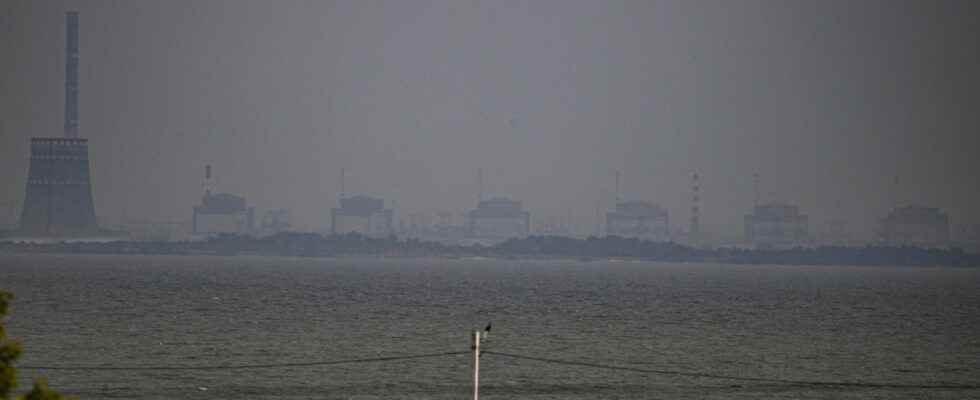Counter-offensive by Ukrainian forces and heavy Russian bombing, southern Ukraine remains at the heart of the conflict overnight from Monday to Tuesday, while UN experts are expected at the Zaporijia nuclear power plant. The mission of the International Atomic Energy Agency (IAEA) must inspect the plant, the largest in Europe, occupied since the beginning of March by the Russians and at the center of all tensions. The Ukrainian counter-attack is essentially aimed at retaking Kherson, a city – of 280,000 inhabitants before the conflict – which fell into Russian hands at the start of the war on February 24, local officials announced.
Information to remember:
- Two civilians were killed and 24 injured in Mikolaiv
- “Ukraine is taking back what is hers and will take back everything in the end”, assures Volodymyr Zelensky
- Russia for its part claimed to have repelled “offensive attempts” in the regions of Kherson and Mykolaiv
- An IAEA mission is expected at the Zaporizhia power plant
“The Ukrainian armed forces have launched their offensive in several areas in the south. We ask the residents of Kherson to follow the security instructions,” regional administration chief Yaroslav Yanuchevych wrote on Telegram. “Today there were powerful artillery attacks on enemy positions (…) throughout the territory of the occupied Kherson region. This is the announcement of what we have been waiting for since the spring: it is the beginning of the end of the occupation of the Kherson region”, located at the gates of Crimea annexed by Moscow in March 2014, announced on Ukrainian television the deputy Serguiï Khlan.
He assured that the Ukrainian military had the “advantage” on the southern front after repeated strikes in recent weeks on bridges and a dam on the Dnieper River, intended to disrupt the logistics of Russian troops. The Ukrainian military group “Kakhovka” said it observed the retreat of a unit of pro-Russian separatist fighters from its positions in the region.
The offensive “failed”, according to Moscow
Russia for its part claimed to have repelled Ukrainian “offensive attempts” in the regions of Kherson and Mykolaiv, also in southern Ukraine. “During the day … Ukrainian troops attempted an offensive in three directions, in the Mykolaiv and Kherson regions,” the Russian Defense Ministry said, adding that it had “lamentably failed” and that the Ukrainians had “suffered heavy losses”. The spokeswoman for the Ukrainian army’s “Southern” command, Natalia Goumenyuk, had previously said that kyiv forces were attacking “from many directions” on this front in order to push the Russians back to the left bank of the Dnieper.
During the night of Monday to Tuesday, this command clarified on Facebook that the situation remained “tense” in its area of action, stressing that “the enemy attacked our positions five times, but all of them were a failure”. He also mentioned a “massive bombardment during the day” of Mikolaiv by the Russians with sixteen S-300 anti-aircraft missiles which caused “significant” damage, particularly to residential buildings and transport infrastructure. Two civilians were killed and 24 injured, according to this source. Two missiles fell in the evening in the Bachtansky region, damaging houses but no casualties were reported at this stage, she added.
“Ukraine is taking back what is hers”
All of this information was unverifiable from independent sources. “Ukraine is taking back what is hers and will take back everything in the end – the regions of Kharkiv, Lugansk, Donetsk, Zaporizhia, Kherson, Crimea, the waters of the Black Sea and the Sea of Azov ( …)”, hammered in his daily evening message Ukrainian President Volodymyr Zelensky. The Russian bombardments have also not ceased on the front line which extends from north to south.
The local authorities notably mentioned strikes in the regions of Kharkiv (north-east), Dnipropetrovsk (center), where they killed one person, and Mykolaiv. “It was shaking and everyone ran out,” Olga, a 40-year-old resident of Mykolaiv, told AFP after a missile and rocket fell in her neighborhood. “It happened in a second and, in a second, it was dark in the house,” testified one of his neighbors, Oleksandre Tchoula, 66, whose wife had just been killed.
An IAEA mission in Ukraine
Governor of the Zaporizhia region (south) Oleksandre Staroukh announced at dawn on Tuesday that Russia had launched an attack with missiles against the eponymous city. “According to initial information, there are no casualties. So far, no major damage to infrastructure has been identified,” he said. It is in this region that IAEA experts are expected. The UN organization has indeed announced that it will send a mission, led by its director general Rafael Grossi, to the Zaporijia power plant. She must visit “later this week” these facilities.
Rafael Grossi had been asking for several months to be able to go there, warning of the “real risk of nuclear disaster” after a series of bombings for which the two belligerents held each other responsible. The G7 countries said on Monday they were “deeply concerned” by the risk of a nuclear accident in Zaporizhia, calling for complete freedom of movement to be granted to international experts. “Russia must ensure safe and unhindered access” to the IAEA team, claimed an American official, for whom the “safest” option would be a “controlled” shutdown of the reactors.
Russia considers this inspection “necessary”
Accused by kyiv of having positioned artillery pieces on the site of the power plant, Russia deemed this inspection “necessary”, through the voice of Kremlin spokesman Dmitri Peskov. The Ukrainian operator Energoatom nevertheless claimed that the Russian soldiers “put pressure on the staff of the plant to prevent them from revealing evidence of the occupier’s crimes”.
“Ukrainian sovereignty over this plant must not be disputed,” said French President Emmanuel Macron. The town hall of Zaporizhia said since August 23 has been distributing iodine tablets to the population within a radius of 50 kilometers around the plant, to be taken in the event of a radiation alert.
